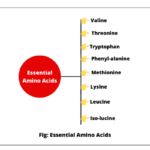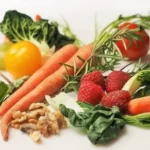Nutrition Quiz: 30 MCQs for Competitive Exams (2025)
Welcome to this Ultimate Nutrition Quiz! This MCQ quiz contains 30 multiple-choice questions based on nutrition and nutrients, which will test knowledge in nutrition topic as well as also enhance your knowledge. These 30 questions are very important for those who are biology students or preparing for the competitive exams like NEET, SSC CGL, RRB, UPSC, IES, etc.
So, are you ready to test your knowledge and score 30/30? Let’s start from the question number 1.
1. What is the process by which an organism uses food for energy, growth, development, and protection from diseases called?
A. Respiration
B. Digestion
C. Nutrition
D. Excretion
c
Nutrition is the biological process in which organisms consume and utilize food to obtain energy, build body tissues, grow, and protect themselves from diseases.
2. The organisms that can prepare their own food using sunlight through photosynthesis are called
A. Heterotrophs
B. Decomposers
C. Parasites
D. Autotrophs
d
Autotrophs, such as green plants, make their own food using sunlight, carbon dioxide, and water through the process of photosynthesis.
3. Organisms that cannot make their own food and rely on others for nutrition are called
A. Autotrophs
B. Producers
C. Heterotrophs
D. Saprotrophs
c
Organisms that cannot make their own food and depend on other organisms (like autotrophs) for nutrition are called heterotrophs. They depend on autotrophs or other organisms for their food because they cannot synthesize their own. Animals are mainly heterotrophs.
4. What are the three macronutrients essential for human health?
A. Vitamins, minerals, water
B. Carbohydrates, proteins, fats
C. Fiber, sugar, salt
D. Calcium, iron, zinc
b
Carbohydrates, proteins, and fats are major nutrients called macronutrients. Macronutrients provide energy. Carbs fuel the body, proteins build muscles, and fats support cell function.
5. Which of the following are called micronutrients or protective principles of food?
A. Vitamins and Minerals
B. Proteins and Vitamins
C. Carbohydrates and Vitamins
D. Minerals and Water
a
Vitamins and minerals are required by the body in small amounts, hence called micronutrients. They help in protecting the body from diseases and maintaining proper health. Therefore, micronutrients are also called protective principles of food.
6. Which of the following lists includes all the essential components of a balanced diet?
A. Carbohydrates, Proteins, Fats, Vitamins
B. Proteins, Fats, Water, Vitamins
C. Carbohydrates, Proteins, Fats, Vitamins, Minerals, Water, and Roughage
D. Carbohydrates, Fats, Water, Minerals
c
Carbohydrates, proteins, fats, vitamins, minerals, water, and roughage are the seven essential components of balanced diets. They provide energy, supporting growth, and maintaining health for proper body function.
7. Which nutrients are primarily responsible for providing energy to the body?
A. Vitamins and Minerals
B. Carbohydrates and Proteins
C. Carbohydrates and Fats
D. Roughage and Proteins
c
Carbohydrates and fats are the main sources of energy for the body. Carbohydrates provide quick energy, while fats serve as long-term energy reserves.
8. Which nutrient is known as the body-builder?
A. Proteins
B. Carbohydrates
C. Fats
D. Vitamins
a
Proteins help build and repair body tissues, muscles, and organs, which is why they are called body building food.
9. Which nutrients mainly act as metabolic regulators in the body?
A. Carbohydrates and Fats
B. Proteins and Roughage
C. Vitamins and Minerals
D. Water and Roughage
c
Vitamins and minerals are called metabolic regulators because they regulate body processes like metabolism, immunity, and cell repair.
10. What type of nutrition involves the intake of solid or liquid organic matter followed by internal digestion?
A. Autotrophic nutrition
B. Saprotrophic nutrition
C. Holozoic nutrition
D. Parasitic nutrition
c
Holozoic nutrition is a type of heterotrophic nutrition where organisms consume organic food (solid or liquid) and digest it inside their body. It is common for animals and humans.
11. What type of nutrition involves organisms feeding on dead and decaying organic matter through the external digestion?
A. Parasitic nutrition
B. Holozoic nutrition
C. Symbiotic nutrition
D. Saprophytic nutrition
d
In saprophytic nutrition, organisms like fungi and some bacteria digest food externally by releasing digestive enzymes on dead matter and absorb the resulting nutrients externally. This is called external or extracellular digestion.
12. What type of nutrition involves organisms living on or inside another organism and deriving nutrients from it?
A. Symbiotic nutrition
B. Saprophytic nutrition
C. Parasitic nutrition
D. Holozoic nutrition
c
Parasitic nutrition is a type of heterotrophic nutrition where one organism (parasite) lives on or inside another living organism (the host) and derives its nutrients from it. Examples of such organisms are lice, tapeworms, and leeches.
13. What is the mode of nutrition in which organisms prepare their own food using sunlight, water, and carbon dioxide?
A. Holozoic nutrition
B. Parasitic nutrition
C. Saprophytic nutrition
D. Autotrophic nutrition
d
Autotrophic nutrition is the mode of nutrition in which organisms like green plants make their own food through photosynthesis.
14. A green plant that makes its own food is an example of:
A. Heterotroph
B. Parasite
C. Autotroph
D. Saprotroph
c
Organisms that make their own food using sunlight (photosynthesis) or inorganic compounds (chemosynthesis) are called autotrophs. Examples are green plants or trees, algae, cyanobacteria, etc.
15. Which of these organisms shows holozoic nutrition?
A. Mushroom
B. Frog
C. Cuscuta
D. Algae
b
Frogs ingest insects and digest them internally, unlike fungi (saprophytic) or parasitic plants (Cuscuta).
‘
16. Which of the following organism does not exhibit holozoic nutrition?
A. Human
B. Lion
C. Amoeba
D. Mushroom
d
Mushrooms, fungi, and bacteria are saprophytic (feed on dead matter), while human beings, lions, eagles, and amoeba are holozoic.
17. The process of carbohydrate synthesis in which the organism uses chemical reactions to obtain energy from inorganic compounds is called…
A. Photosynthesis
B. Chemosynthesis
C. Heterotrophism
D. Decomposition
b
Chemosynthesis is the process where organisms (such as deep-sea bacteria) synthesize carbohydrates by using energy from inorganic chemical reactions.
18. Organisms that cannot produce their own food and must obtain energy by consuming other organisms are called….
A. Chemotrophs
B. Heterotrophs
C. Decomposers
D. None of the above
b
Organisms that cannot produce their own food and obtain energy by consuming other organisms or organic matters are called heterotrophs. These organisms cannot convert inorganic substances into organic compounds (food) like plants do through photosynthesis. Examples of heterotrophs are animals, fungi, and many bacteria.
19. Which nutrient is the main source of energy for the body?
A. Protein
B. Carbohydrates
C. Vitamins
D. Minerals
b
Carbohydrates are broken down into glucose, which provides energy for body functions and activities.
20. Which vitamin is mainly obtained from sunlight?
A. Vitamin A
B. Vitamin B12
C. Vitamin C
D. Vitamin D
d
Our skin produces Vitamin D when exposed to sunlight. It helps in calcium absorption and bone health.
21. Which mineral is essential for healthy bones and teeth?
A. Iron
B. Calcium
C. Zinc
D. Potassium
b
Calcium is the most important mineral for building and maintaining strong bones and teeth.
22. Which of the following is a fat-soluble vitamin?
A. Vitamin B
B. Vitamin C
C. Vitamin D
D. All of the above
c
Vitamins like A, D, E, and K are fat-soluble vitamins, which dissolve in fats and are stored in the body.
23. Which of the following nutrient helps carry oxygen in the blood?
A. Iron
B. Vitamin B12
C. Magnesium
D. Iodine
a
Iron is a key component of hemoglobin, which transports oxygen in red blood cells.
24. What is the main function of antioxidants in the body?
A. To neutralize harmful free radicals.
B. Preventing or slowing down cell damage.
C. Potentially reducing the risk of chronic diseases like heart disease and cancer.
D. All of the above
d
All are functions of antioxidants in the body.
25. Where does most nutrient absorption occur?
A. Stomach
B. Liver
C. Small intestine
D. Large intestine
c
The small intestine absorbs most of the nutrients in your food, and your circulatory system passes them on to other parts of your body to store or use.
26. What is malnutrition?
A. Eating only fatty food
B. Lack of water intake
C. A condition caused by lack of proper nutrients
D. None of the above
c
Malnutrition occurs when the body doesn’t get enough nutrients, leading to health problems.
27. Which of the following food group is not the best source of dietary fiber?
A. Whole grains
B. Legumes
C. Fruits and Vegetables
D. Meat
d
Fiber is found in plant-based foods like whole grains, fruits, and vegetables.
28. Which nutrient helps in the clotting of blood?
A. Vitamin A
B. Vitamin B12
C. Vitamin K
D. Vitamin D
c
Vitamin K plays a key role in helping blood clot, preventing excessive bleeding.
29. Which nutrient is most important for muscle recovery after exercise?
A. Proteins
B. Fats
C. Carbohydrates
D. Minerals and Water
a
Protein provides amino acids to repair and build muscle tissue.
30. Which of the following statement is not correct about nutrition and nutrients?
A. Our bodies require over 40 essential nutrients required by the human body to maintain health and well-being.
B. Saturated fat is not an essential nutrient because the body can synthesize it.
C. Nutrients also act as regulators for functions of the body.
D. The human body can produce all the essential amino acids it needs.
d
The human body cannot produce all nine essential amino acids it needs. The nine amino acids are histidine, isoleucine, leucine, lysine, methionine, phenylalanine, threonine, tryptophan, and valine. These must obtain them through the diet.
Quiz Results
Total Questions: 0
Correct Answers: 0
Incorrect Answers: 0
Score: 0%







